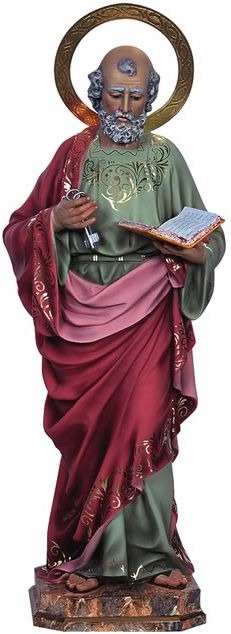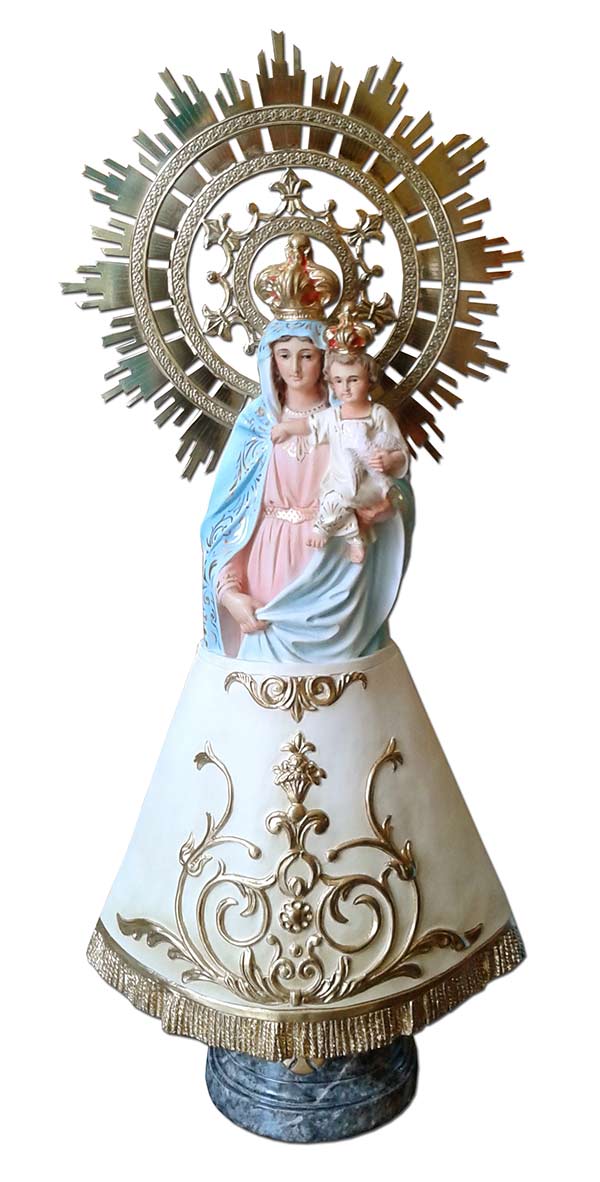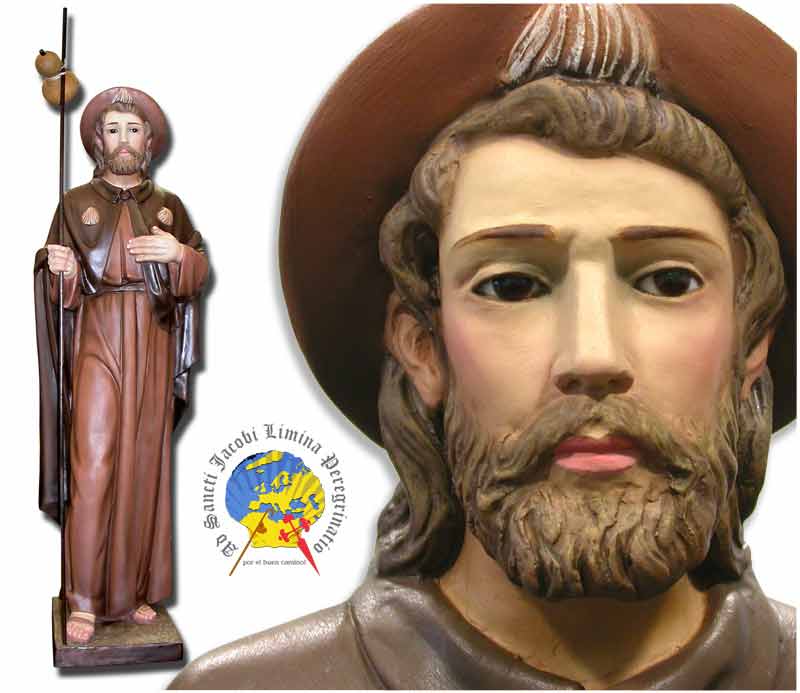
Saint James, The Great | Catholic Church figure
Saint James, The Great | Catholic Church spanish figures
The Saint James are one of the most recognized religious figures in Spain. Saint James is the Spanish patron saint. Throughout the history of Spain, Saint James has protected all Christians against their enemies.
In addition to the St. James figurine, in our online store we have a wide variety of pieces of religious imagery for sale. Within the religious images section, our buyers are especially interested in the spanish handmade catholic statuary. Pieces of high artistic value due to the laborious artisan process that is necessary for their manufacture.
We talk about the Saint James figurines . Being as we are a Galician religious articles company, our link with Saint James is very close. All Galicians celebrate the Galicia feast, on July 25, Saint James the Greater feast.
Our entry will focus on a religious image of which we are especially proud: the religious figurine of St James dressed in the typical clothes of the pilgrims to Compostela and decorated with the shells of Santiago . We have divided the text into two parts. The first part of the text will talk about the origin of the name of Santiago and about the trip from St James to Hispalis. In the second part of the text we will focus on the manufacturing process of the Saint James figurine.
This Saint James statue is very important to us because it is a piece of imagery from Olot that Brabander Religious Articles sells exclusively worldwide. Anyone who wishes to buy this work of religious imagery can only find it in our online store of religious articles.
The image of Santiago the pilgrim is a handcrafted piece made following the criteria that have made spanish catholic figurines world famous.
Saint James the Greater, the name origin
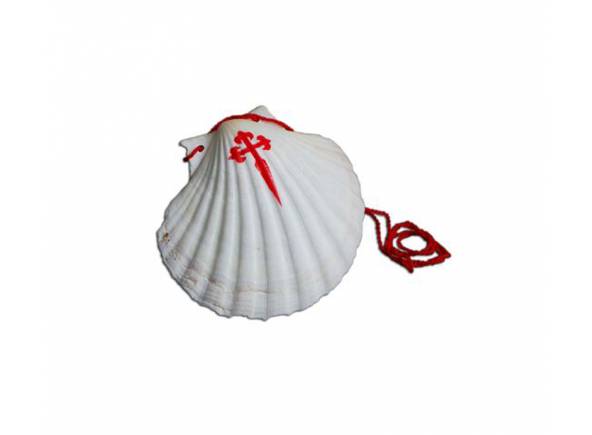 Before talking about the St. James sculpture, we will talk about the Saint James name.
Before talking about the St. James sculpture, we will talk about the Saint James name.
The Saint James name (Santiago in Spanish) comes from the Hebrew of Iacob, or Jacob. It is believed that the name of Saint James did not begin to be used until many years after the Saint's death. The name of Saint James comes from the fusion of the word Santo (or Sant) and Iacob or Jacob .
According to several studies, it is considered that it was the Spaniards, Saint James is the patron saint of Spain, who began with the use of Santiago since they went to battle they entrusted themselves to their patron shouting "Sant Iago, protect us" or "Sant Iago help us". Over the years the two words ended up merging into one.
In the Bible we know him as James the Greater , to differentiate him from the other Apostle who had the name of James, known as James the Less. The reason Saint James is known as The Great (or The Greater) was because he was older.
St. James figurines
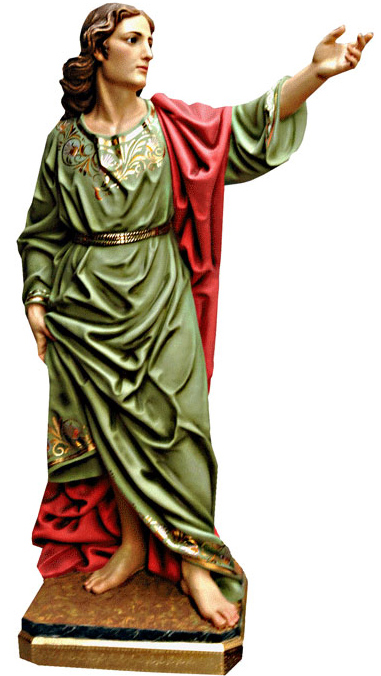 Within the immense variety of pieces of Spanish catholic statuary that we have in our online store, the image of St. James occupies a very important place, exactly like the Saint James occupied in the life of Jesus.
Within the immense variety of pieces of Spanish catholic statuary that we have in our online store, the image of St. James occupies a very important place, exactly like the Saint James occupied in the life of Jesus.
James the Greater was one of the twelve Apostles and had an especially close relationship with Christ. Saint James, along with Saint John the Evangelist, his brother, and Saint Peter formed part of the group of Jesus' favorites.
Saint James witnessed all the miracles of Christ, was present at the moment of the Transfiguration of Christ and during the Prayer in the Garden of Gethsemane.
As we know, the Apostle Saint James was the son of Zebedee and Salome, who, according to some sources, was a cousin of the Virgin Mary. The Saint James family was dedicated to fishing in Lake Tiberius.
One day, while he and his brother Saint John were fishing, Jesus found them and asked them to follow him. The two brothers, realizing who Jesus was and what he represented, did not hesitate to leave their nets and join him. In this way, and just as Our Lord had announced, they ceased to be fishermen and became fishers of men
St. James the Great travels to the end of the world
Before his death Jesus told his disciples:
“Go into all the world and preach the Gospel to every creature. He who believes and is baptized will be saved; but whoever does not believe will be condemned.”
After the death of Our Lord Jesus Christ, Saint James thought about those words that Jesus had said to him. He had always been one of the closest to Christ and wanted to fulfill his Master's last wish.
After deep meditation, he decided to travel to the end of the known land (Finisterrae), a place located in the distant region of the Roman Empire known as Hispania Tarraconensis.
Before beginning his journey he visited the Virgin Mary, who at that time was residing with Saint James' brother, Saint John the Evangelist. After receiving the blessing of the Virgin, he left for the distant lands of the West.
After a long journey, he arrived in Galaecia, land of Galicians and Asturians, land of pagans. Saint James decided to begin his evangelization in that place. His faith was great and his will unbreakable. Despite his titanic effort he did not get a great reward, the people of those places did not understand his message, the message of Jesus.
After some time he decided to continue his work elsewhere. He traveled through the north of the peninsula and arrived at a place called Caesaraugusta, currently known as Zaragoza.
Again, without losing hope, he began his evangelizing work. After a long time he managed to convert eight men into Christians. He had achieved a great achievement, but Saint James was not satisfied. Inside he believes that he was failing Jesus.
The apparition of the Virgin of El Pilar
One day, January 2 of the year 40 AD. According to tradition, Saint James decides to pray alone on the banks of the Iberus Flumen river, now Ebro. The St. James begins to pray with deep devotion. Shortly after praying, he hears a song. It is such a beautiful song that it seems sung by the Angels themselves.
At that moment, an image of the Virgin Mary appears and tells him:
“Here is my son Jacobo (or Saint James), the place of my choice. Look at this pillar that I sit on, sent by my son and your teacher. On this land you will build a chapel. And the Most High will work, for Me, admirable miracles on all those who implore, in their needs, my help. East The pillar will remain here until the end of time, so that worshipers of Jesus Christ will never be lacking.”
The image of the Virgin Mary was on a jasper pillar.
The words of the Virgin Mary are medicine for the soul of the Saint James. Helped by his apprentices, he begins to build a chapel around the pillar that the image of the Virgin had brought in her appearance. Even before the work is finished, St. James consecrates it and gives it the title of Holy Mary of El Pilar, thus becoming the first church in Christendom dedicated to the Virgin Mary.
That small primitive temple will be the base for the evangelization of the westernmost part of Europe. Over the years it will evolve and become what is today the Basilica of the Virgin of El Pilar. In the main altar of the Basilica remains the pillar with the Virgin Mary of El Pilar figure .
Spanish handmade St. James statue for sale
Once we have talked about the historical importance of Saint James. We will focus on the process of making the image . Piece of imagery, which, as we have said before, is only sold by Religious Articles Brabander.
The manufacturing process of the Saint James figure , like that of all the spanish statuary, begins with the making of a model that will serve as the basis for making the mold. This original image is carved by a sculptor, who creates with his hands the model for the realization of the molds.
The original Saint James sculpture was only considered finished when the artist and the designers of Brabander Religious Articles were totally satisfied. It was very important that the image of the St. James the Greater had a sweet expression on his face and a perfectly proportioned body.
From this original statue, a first mold and a counter-mould were made, also known in the religious imagery sector as charpa. The charpas are usually made of wood, burlap and pasta. The mold and counter-mold of the St. James de Great statue are the negatives that we use as a base for the manufacture of the figures that can be purchased in our store.
It is a laborious process, full of small details. Any image that comes out of the spanish workshops usually follows this same path. In the case of the figure of Saint james the Greater there is an added complication: the right arm, with which he holds the pilgrim's staff, could not be included in the original mold. The disposition of this arm, extended with the gesture of holding the cane, forced an alternative solution to be sought.
The spanish artisans decided to make a second mold, that is, they would carve and create a specific mold for the manufacture of the arm and then assemble it in the mold and counter-mold of the body part of Saint James.
With this decision, more complex but more effective than other alternatives, a perfect integration of the arm and hand of Saint James in the main body of the figure was guaranteed.
For sale other items related to the Saint James way, such as the Saint James scaulpar .
